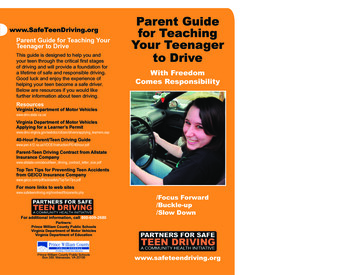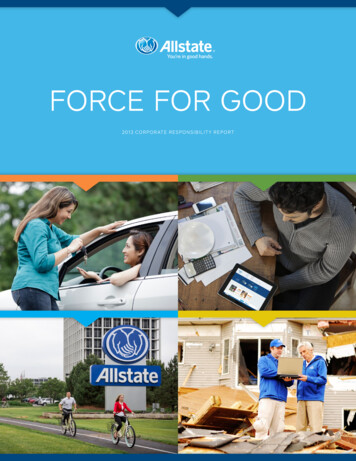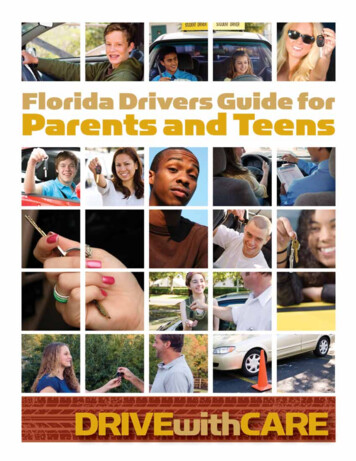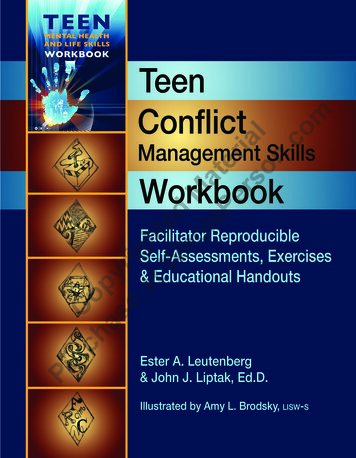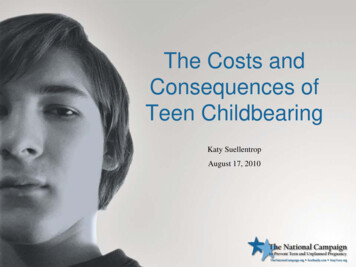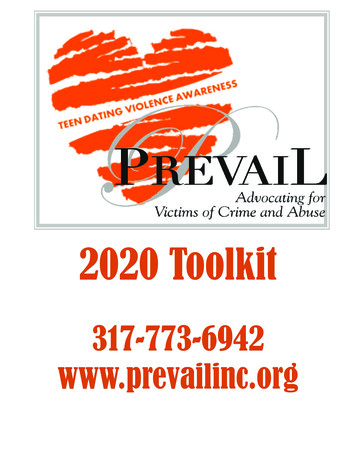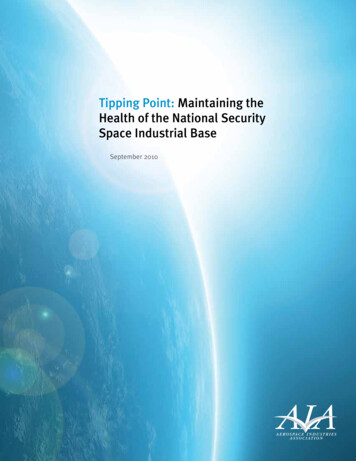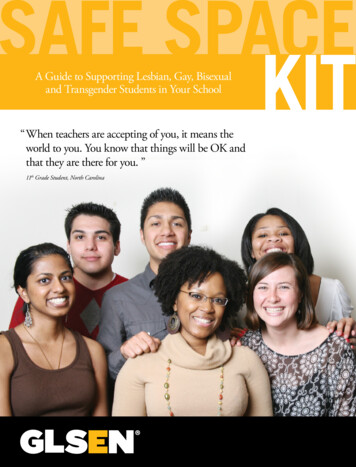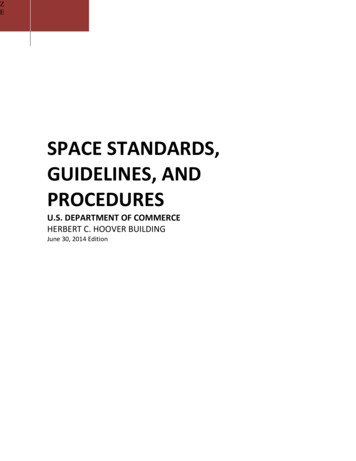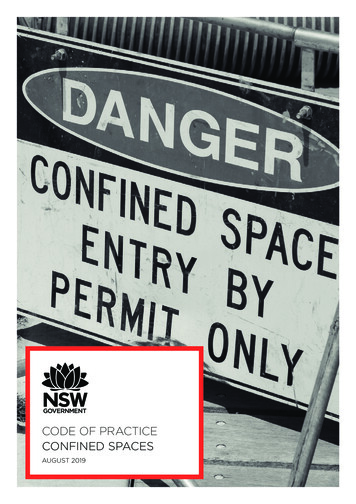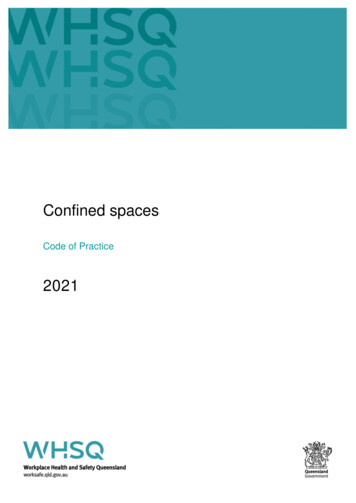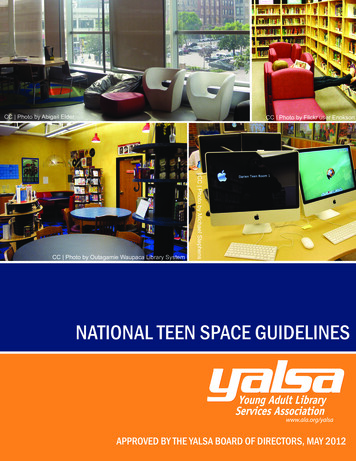
Transcription
CC Photo by Abigail ElderCC Photo by Flickr user EnoksonCC Photo by Michael StephensCC Photo by Outagamie Waupaca Library SystemNational teen space guidelinesapproved by the YALSA Board of Directors, MAY 2012
ForewordThese guidelines were created in 2011 -2012 by a task force of the Young Adult Library Services Association(YALSA) with feedback from the library community achieved through a public comment period in the fallof 2011. Members of the task force were Katherine Trouern-Trend (chair), Audrey Sumser, Kathy Mahoney,Caroline Aversano, Samantha Marker, and Kimberly Bolan Cullin. YALSA’s Board of Directors adopted theguidelines on May 24, 2012.Review ProcessIn order to finalize the guidelines, the taskforce presented a draft document to YALSA’S Board of Directorsin June 2011. At this meeting, the taskforce solicited feedback on the draftThe feedback was carefully considered by the Taskforce; additions and revisions have been madeaccordingly. This draft document was approved for dissemination via a call for public comments period onOct. 14, 2011. After the public comment period closed, the taskforce reviewed the feedback received andrefined the draft guidelines as appropriate. The Teen Spaces Guidelines Taskforce wishes to thank the librarycommunity for their contributions to this document. It is intended that the National Teen Space Guidelineswill be reviewed for revisions every five years.
IntroductionThis is a tool for evaluating a public library’s overall level of success in providing physical and virtual spacededicated to teens, aged 12-18. Potential users of these national guidelines include library administrators,library trustees, teen services librarians, community members and job-seekers hoping to assess a library’scommitment to teen services. Not every element of the guidelines may apply to every public library situation,but the guidelines can serve as a place to begin the conversation about what constitutes excellent public libraryspace for teens.Teens experience rapid physical, emotional and social changes while developing their intellectual capabilitiesand personal values, understanding and accepting their sexuality, and identifying their educational andoccupational options. Libraries are vital to today’s teens in order for them to achieve a successful transitionfrom childhood to adulthood. They offer the resources and the environment that foster positive intellectual,emotional and social development of tomorrow’s adults. All of these factors contribute to the need for distinctteen spaces, both in-library and virtually. The national guidelines that follow are intended for all librarypersonnel working with and for teens, so they can fully understand the mission of library service to thisfrequently underserved age group and the importance of dedicated physical and virtual teen spaces for theircontinued engagement, growth and achievement.The mission of the Young Adult Library Services Association (YALSA) is to expand and strengthen libraryservices for teens. Through its member-driven advocacy, research, and professional development initiatives,YALSA builds the capacity of libraries and librarians to engage, serve, and empower teens and youngadults. YALSA is a subspecialty of the American Library Association, the world’s largest and oldest libraryorganization, and a financially stable 501(c)3 not-for-profit.To learn more about YALSA or to access other national guidelines relating to library services to teens, go towww.ala.org/yalsa.Guidelines for Physical Space1.0 Solicit teen feedback and input in the design and creation of the teen space.A cornerstone of teen library services is the principle that teens must be actively involved in decisionsregarding collections, services, and programs intended for them. Their active participation ensures thatthe evolving needs and interests of teens are being addressed, and they play a key role in attracting peersto the library. Teens become lifelong library users and supporters when they are enthusiastically engagedin planning and decision-making, and their sense of ownership will enhance the quality of their libraryexperience.1.1Create a space that meets the needs of teens in the community by asking teens to play a role in theplanning process.1.2Solicit teen feedback in the design of the space and regarding its use to allow teens to develop asense of ownership.1.3Solicit teen feedback in the development of policies to ensure the space is representative of teenneeds.
2.0 Provide a library environment that encourages emotional, social and intellectualdevelopment of teens.Twenty-first century teens have an unprecedented power and enthusiasm in shaping their social and learningenvironments through the growth of digital communication. These tools have created new social norms andexpectations for teens from diverse backgrounds. Public libraries must strive to recreate this online experienceby hosting an inviting, high interest, multipurpose physical space for teens. In doing so, the library nurturesteens’ values, identity, and the new skills necessary to grow and thrive. The environment should:2.1Convey that it is teen-owned and maintained.2.2Be comfortable, inviting, open and have a vibrant and teen-friendly look and feel.2.3Accommodate individual as well as group use for socializing and learning.2.4Include colorful and fun accessories selected by teens. Include up-to-date and teen friendly décor.2.5Allow for ample display of teen print, artistic and digital creations.2.6Allow food and drink in the space.2.7Contribute to a sense of teen belonging, community involvement, and library appreciation.2.8Be appealing to both users and non-users and provide resources for customers from diverse socialgroups, backgrounds and interests.2.9Be easy to navigate with clear signage and distinct areas for socializing, entertainment, teen print/digital collections and study and quiet areas.2.10 Be easily navigable for teens with wheelchairs, walkers and other assistive devices3.0. Provide a library space for teens that reflects the community in which they live.Twenty-first century teens have the ability to select and engage in communities of their choice based oninterest and identification with cultural, social and knowledge groups. A public library must provide aspace for teens that builds upon the culture and size of the teen community and facilitates user-friendlyengagement in the space. The space should:3.1 Reflect the communities the library serves.3.2 Be proportionate in size to the percentage of a community’s teen population.3.3 Incorporate creative design and signage to make it evident that the area is for teens.3.4 Be designed and located to accommodate noise and activity away from quiet areas of the library andthe children’s area.3.5 Provide easy access to research materials and staff assistance.3.6 Provide separate rooms for programming and quiet study spaces.3.7 Encourage visibility for unobtrusive staff supervision.3.8 Accommodate a variety of uses including leisure reading, socializing, and individual and group activity.3.9 Provide workspace for the teen librarian.3.10 Have adequate and appropriate shelving for a diverse collection, displays and exhibit space.43.11 Designed to be handicapped accessible and in compliance with the Americans with Disabilities Act(ADA).
4.0 Provide and promote materials that support the educational and leisure needs of teens.According to Lee Rainie, director of the Pew Internet and American Life Project, the mobile revolutionhas changed people’s sense of time, place and presence and has lead to a new media ecology . This sets anew standard for the expected immediacy and availability of desired information in all formats. Librarieshave an important role in providing appropriate materials to help teens navigate, consume and createinformation for entertainment and lifelong skill development.4.1 Ensure a teen collection development policy is in place that is aligned with the mission and goals ofthe library and the library’s overall collection development policy.4.2 House materials within the space that address the unique emotional, intellectual, and social maturityof middle and high-school age adolescents.4.3 Maintain a teen collection that supports and addresses the interests and needs of teens in thecommunity.4.4 Maintain materials that are evaluated and weeded on a timely basis for condition and relevance.4.5 Maintain a teen collection that includes a wide variety of formats, including but not limited to:4.5.a Print fiction and non-fiction4.5.b. Music, including but not limited to CD, MP3, and other emergent technologies.4.5.c. Video resources, including but not limited to DVD, Blu-Ray and other emergenttechnologies.4.5.d. Downloadable books.4.5.e. Downloading stations for in-library use.4.5.f. Circulating hardware, including but not limited to laptops, eReaders, MP3 players and otheremergent technologies4.5.g. Audiobooks and other emergent technologies.4.5.h. Graphic novels, manga, comic books, and anime.4.5.i. Video games and gaming systems.4.5.j. Magazines, both recreational and educational.4.5.k. Electronic databases and other digital research materials.4.5.l. Print research materials.5
5.0 Ensure the teen space has appropriate acceptable use and age policies to make teens feelwelcome and safe.The teen space is intended for use by customers age 12-18 years old, and its purpose is to centralize theinformation and recreation resources of this age group while offering teens a safe, supportive, and positivespace that is uniquely their own.5.1 Actively seek teen input in the creation of the teen space guidelines, empowering theteens to serve asvaluable resources.5.2 Clearly state and display guidelines once they have been discussed and determined.5.3 Ensure that both staff and the public are aware of the rules and expectations for using the space.5.3 Address common points and behaviors within the guidelines, including but not limited to:5.3.a Age requirement5.3.b. Use of appropriate language and behavior, including no fighting, no public displays ofaffection, and cleaning up one’s mess.5.4 Expect teens to respect themselves and the space and convey this clearly in the guidelines.5.5 Consider adopting a “teen-only” policy for use of the space to create a space that is uniquely theirown. A teen-only space can:5.5.a. Indicate to teens that the library cares about their unique developmental, recreational,educational, and social needs.5.5.b. Enable teens to be themselves in a teen-friendly environment.5.5.c. Help teens feel more at ease in the library.5.5.d. Help contain noise levels that may be distracting to other patrons.5.5.e. Contribute to the safety and well-being of teens while in the library.5.6 Limit adult use of the teen-only space to browsing materials for a period of time not to exceed 15minutes, adult tutors who are currently working with teen students, adults accompanied by a teen,and library staff. This space can:5.6.a. Allow teens to feel comfortable in an area where other teens are the primary occupants.5.6.b. Enable teens to feel safe from risky, adult-initiated interactions.6
6.0 Provide furniture and technology that is practical yet adaptive.The space is designed to accommodate a variety of activities and is flexibly arranged so these activities cantake place easily. Furniture, fixtures and technology should be multifunctional and flexible so that as needsand activities change the area can be adapted accordingly. The selected furniture and fixtures should beconducive to marketing library material through displays and arrangements that stimulate discovery anduse. Browsing areas for materials should encourage teens to engage in the library at their own pace andcomfort level.6.1 Have shelving for materials in various formats.6.2 Provide comfortable and durable seating and tables for teens of all sizes and abilities. Includefurniture that is wheelchair accessible.6.3 Include furniture that is easy to move around the space in order to allow for a multitude of group,individual, and programmatic activities.6.4 Include display equipment such as bulletin boards and display cases.6.5 Ensure ample trash receptacles are available.6.6 Provide a reference or information services desk or kiosk, clock, and telephone as well as amplestorage for teen librarian’s supplies.6.7 Offer listening, viewing, and downloading equipment for a full range of user abilities/needs. Ensureassistive hardware and software technology is available for vision and hearing disabled teens.6.8 Be technology rich and include both stationary and portable technology that is easily accessible andexposes teens to a diversity of hardware and software for both entertainment and learning.6.9 Offer access to current and emerging platforms and tools, including but not limited to socialnetworking and photo-sharing sites, user-driven communication tools for tagging and reviewsharing, audio and visual production technologies, and interactive Web services.6.10 Provide adequate lighting, ventilation, temperature controls, and acoustics.6.11 Include ample outlets to allow for technology owned by the library as well as technology owned andbrought into the space by teens.6.12 Provide adequate network infrastructure.6.13 Ensure wireless capability.7
Guidelines for Virtual Spaces7.0 Ensure content, access and use is flexible and adaptiveOnline communication and engagement is central to the rhythms of teenagers’ lives. Many teens have selfstructured identities and social environments online and exist in a rapidly converging virtual and physicalworld. According to Pew researchers, three-fourths of teenagers contribute content online and are keyplayers in the digital information revolution. Traditionally libraries have sought to push information outto library users through librarian-created content, but it is vital in today’s world to recognize and adapt tothe changing information needs and expectations of our teen patrons. Teens should be active participantsin the creation and maintenance of the library’s online presence. An attractive and functional virtual spaceshould be designed with teen input, evaluated regularly by teens, have interactive features, and be usable ona mobile device. The virtual space should:7.1 Support and use social media as a vital means of communication.7.2 Allow teens to share their work, receive feedback and build community.7.3 Model safe and appropriate use of social media tools for teens.7.4 Support collaboration with adults and peers.7.5 Allow administrative rights and content contribution to both library staff and teens.7.6 Be interactive.7.7 Support and feature mechanisms for teens to connect in real time virtually with library staff who canassist them with research needs such as chat, text message, and Skype, among others.7.8 Support and feature mechanisms for teens to connect with one another through the library websiteto talk about books, homework, and research.7.9 Support and provide capabilities for taking part in programs virtually.7.10 Offer classes, drop-in sessions, and/or virtual instruction to educate and teach use of Web 2.0 toolsand other emerging technologies.7.11 Provide positive online interactions modeled by library staff.7.12 Include content, photos and videos produced by teens in accordance with the library’s photo releasepolicy.7.13 Designed to be accessible for those with visual, auditory, and motor disabilities. See The Internetand Web-based Content Accessibility Checklist nternetwebguidelines) provided by the Association for Specialized and Cooperative LibraryAgencies.8
8.0 Ensure the virtual space reflects 21st century learning standards.Through interaction and participation in digital media, teens are developing important social and technicalskills helping to build a skill set necessary to learn and thrive in today’s networked world. As virtual andphysical worlds continue to converge, teens need tools, support and resources to harness information ina way that is meaningful to their particular needs and as participants in multiple and diverse social andlearning environments.8.1 Help teens thrive in a complex information environment.8.2 Expose teens to diverse perspectives, gather and use information ethically and use social toolsresponsibly and safely.8.3 Support the development of multiple literacies including digital, visual, textual and technologicalinformation navigation and use.8.4 Enhance teen information literacy skills through opportunities to share and learn with others, bothphysically and virtually.8.5 Teach respect for copyright and the intellectual property rights of creators and producers.8.6 Connect understanding to the real world.8.7 Help teens consider diverse and global perspectives.8.8 Engage teens in social and intellectual networks of learning to gather and share information.8.9 Use technology and other information tools to organize and display knowledge and understandingin ways that others can view, use, and assess.8.10 Help teens connect learning to community issues.8.11 Contribute to the exchange of ideas within and beyond the learning community.8.12 Respect the principles of intellectual freedom.8.13 Use creative and artistic formats to express personal learning.9
9.0 Provide digital resources for teens that meet their unique and specific needs.21st century teens interact with a range of materials in multiple formats in their school and leisureenvironments. According to the MacArthur Foundation, we are in the midst of a knowledge revolution thatis changing how we approach learning and leisure resources for youth. Libraries need to adapt to this newparadigm and provide resources and support for teen’s natural gravitation to digital media platforms.9.1 Provide general contact information for the library and specific contact information for the teenlibrarian and teen content creators.9.2 Feature information about library programs and activities for teens.9.3 Feature a collection development policy for website content and links that includes a procedure foraddressing challenges to controversial websites and a procedure for users to suggest additionalelectronic resources.9.4 Feature annotated booklists and book reviews, and/or links to teen literature sites that providereader’s advisory services.9.5 Promote teen collections and resources.9.6 Feature informational and recreational links, including the library catalog, databases, andrecreational links suggested by teens.9.7 Feature interactive information of interest and need to teens including, but not limited to, homeworkhelp; health and sexuality; financial advice; relationship advice; time management tips; popculture; college prep.9.8 Provide opportunities for teens to post reviews of materials.9.9 Provide links to the library’s Teen Advisory Board blog, wiki, Twitter feed, or other means of onlinecommunication.9.10 Feature interactive content that helps teens learn how to use library resources.9.11 Feature content that is changed and updated frequently.10
ResourcesWhile every effot has been made to ensure the accuracy of URLs in this document, please bear in mind thatwebsites change frequently.American Association of School Librarians. 2007. “Standards for the 21st Century Learner.” AccessedMay 31, 2012. guidelinesandstandards/learningstandards/AASL LearningStandards.pdf.Apple in Education. “Useful to Everyone, Right from the Start.” Accessed May 31, 2012. ion of Specialized and Cooperative Library Agencies. 2010. “Assistive Technology: WhatYou Need to Know.” 1-Assistive Technol.pdfBernier, Anthony. 2010. “Spacing Out with Young Adults: Translating YA Space Concepts Back intoPractice.” In The Information Needs and Behaviors of Urban Teens: Research and Practice, editedby Denise E. Agosto and Sandra Hughes-Hassell, 113-126. Chicago: ALA Editions.Bernier, Anthony. 2010. “Ten Years of ‘YA Spaces of Your Dreams’: What Have We Learned?” Voice ofYouth Advocates Online. Accessed May 31, 2012. our-dreams-what-have-we-learned.Bernier, Anthony. 2009. “‘A Space for Myself to Go’: Early Patterns in Small YA Spaces.” Public Libraries48(5): 33–47.Bernier, Anthony and Nicole Branch. 2009. “A TeenZone: Humming Its Own New Tune.” Voice of YouthAdvocates 32(3): 204–206.Bernier, Anthony, ed. 2012. YA Spaces of Your Dreams Collection. Bowie, Md.: VOYA Press.Bolan, Kimberly. 2011. “Best Practice in Teen Space Design Webinar. Accessed May 31, 2012. ondemandBolan, Kimberly. 2008. “YALSA White Paper: The Need for Teen Spaces in Public Libraries.” AccessedMay 31, 2012. s.Bolan (Taney), Kimberly. 2008. Teen Spaces: The Step-by-Step Library Makeover. Chicago: ALAEditions.Braun, Linda. 2010. “The Big App : New York Libraries Take Homework Help Mobile — witha Little Help from Their Friends.” School Library Journal. Accessed May 31, 2012. he big app new yorks.html.csp.Braun, Linda. 2006. “Instant Messages.” YALSABlog. Accessed May 31, 2012. ges.Braun, Linda. 2010. “Whose Space Is It?” YALSABlog, Accessed May 31, 2012. s-it/Daly, Erin. 2012. “30 Days of Innovation: Incorporate Art Into Your Teen Space.” YALSABlog, AccessedMay 31, 2012. novation-11-incorporate-teenart-into-your-space/11
Duffy, Mairead. 2012. “30 Days of Innovation #5: Changing Your Point of Reference.” YALSABlog.Accessed May 31, 2012. y, Michael Garrett. 2012. Make Room for Teens: A Guide to Developing Teen Spaces in Libraries.Santa Barbara, Calif.: Libraries Unlimited.Feinberg, Sandra and James R Keller. 2010. Designing Space for Children and Teens in Public Spaces andLibraries. Chicago: ALA Editions.Fialkoff, Francine. 2010. “Third Place or Thinking Space.” Library Journal. Accessed on May 31, Flowers, Sarah. 2010. Young Adults Deserve the Best: YALSA’s Competencies in Action. Chicago : ALAEditions, 2010.Ito, Mizuko, et. al. 2009. Hanging Out, Messing Around, and Geeking Out: Kids Living and Learningwith New Media. Cambridge, Mass.: MIT Press, 2009.Ito, Mizuko, et al. 2008. “Living and Learning with New Media : Summary of Findings from the DigitalYouth Project. Accessed May 31, 2012. ort/digitalyouth-WhitePaper.pdf.Jones, Patrick, Mary K. Chelton and Joel Shoemaker. 2001. Do It Right: Best Practices for Serving Teensin School and Public Libraries. New York: Neal-Schuman.King, David Lee. 2011. “Content Creation, Media Labs, and Hackerspaces.” David Lee King Blog.Accessed May 31, 2012. edia-labs-andhackerspaces/#.T8IwbZlYt2k.Lenhart, Amanda, et al. 2011. “Teen Kindness and Cruelty on Social Network Sites.” Pew Internet andAmerican Life Project. Accessed May 31, 2012. l-media.aspx.Library Journal and School Library Journal. The Digital Shift: Libraries and New Media. Accessed May31, 2012. www.thedigitalshift.com.Library Roadshow. 2012. “Michelle Shows Us ImaginOn’s Teen Space.” Video. Accessed May 31, 2012.http://youtu.be/5cubsGMSlnA.McGrath, Renee. 2011. “Creating a Mobile Booklist ‘App.’” Young Adult Library Services 10 (2): 35–37.McCue, T.J. 2011. “First Public Library To Create a Maker Space.” Forbes. Accessed May 31, 2012. ic-library-to-create-a-maker-space/Microsoft. “Microsoft Accessibility: Technology for Everyone.” Accessed May 31, 2012. www.microsoft.com/enable.KQED. Mind/Shift: How We Will Learn. Accessed May 31, 2012. http://blogs.kqed.org/mindshift.Peoski, Laura. “Where Are All the Teens? Engaging and Empowering them Online.” Young Adult LibraryServices 8(2): 26–28.Rainie, Lee and Susannah Fox. 2012. “Just in Time Information through Mobile Connections.” PewInternet and American Life Project. Accessed May 31, 2012. .12
Rainie, Lee. 2011. “Libraries and the New Community Information Ecology.” Video presentation.Accessed May 31, 2012. Books.aspx.Reeder, Jessica. 2011. “Are Maker Spaces the Future of Libraries.” Shareable: Science & Tech. AccessedMay 31, 2012. ies-maker-spaces.Search Institute. “Developmental Assets Lists.” Accessed May 31, 2012. s.Toppo, Greg. 2010. “Digital LibraryAims to Expand Kids’ Media Literacy.” USA Today. Accessed May 31,2012. y/50714312/1.Watters, Audrey. 2011. “Libraries and Museums Become Hands-On Learning Labs.” KQED Mind/Shift.Accessed May 31, 2012. Umedia. YOUMedia Web site. Accessed May 31, 2012. www.youmedia.org.Ypulse. 2010. “Ypulse Interview: Kim Bolan Cullin: ‘Teen Spaces.’” Accessed May 31, 2012. n-cullin-teen-spaces13
Model Physical & Virtual Teen Spaces14Library:Location:Teen Space Name:Virtual Space:Contact:Frankfort Community Public LibraryFrankfort, INThe Edgehttp://fcpl.accs.net/teen.htmTom Smith, Assistant Director and Kirsten Weaver, Teen and Outreach LibrarianLibrary:Location:Teen Space Name:Virtual Space:Contact:Waupaca Area Public LibraryWaupaca, WIBest Cellarwww.waupacalibrary.org/teensPeg Burington, DirectorLibrary:Location:Teen Space Name:Virtual Space:Contact:Newark Public LibraryNewark, NYThe Teen Spothttp://newarklibraryteenspot.blogspot.com/Elly Dawson, DirectorLibrary:Location:Teen Space Name:Virtual Space:Contact:Plymouth District LibraryPlymouth, MITeen Zonehttp://plymouthlibrary.org/index.php/teenCathy Lichtman, Teen Service LibrarianLibrary:Location:Teen Space Name:Virtual Space:Contact:Farmington Public LibraryFarmington, New MexicoTeen Zonewww.infoway.org/TeenZone/index.aspBarbara Savage Huff, Youth Services LibrarianLibrary:Location:Teen Space Name:Virtual Space:Contact:Chicago Public Libary, Harold Washington Library CenterChicago, ges/2-about-usMike Hawkins, YouMedia Coordinator/Lead MentorLibrary:Location:Teen Space Name:Virtual Space:Contact:Tacoma Public LibraryTacoma, WAStory Labwww.storylabtacoma.org/Sara Sunshine Holloway, Librarian
Library:Queens LibraryLocation #1:Queens Library for Teens, Far Rockaway, NYVirtual on #2:Flushing Branch, Flushing, NYVirtual Space #2: http://queenslibrary.org/index.aspx?page id 44&branch id FContact:Vikki Terrile, Coordinator of Young Adult ServicesLibrary:Location:Teen Space Name:Virtual Space:Contact:Detroit Public LibraryDetroit, MIH.Y.P.E. (Helping Young People Excel)http://dplhype.org/Lurine Carter, Children’s and Youth Services CoordinatorLibrary:Location:Teen Space Name:Virtual Space:Contact:Orange County Library SystemOrlando, FLClub Centralwww.ocls.info/Children/Teen/doit/club central do it.aspVera Gubnitskaia, Youth Services ManagerLibrary:Location:Teen Space Name:Virtual Space:Contact:Gail Borden Public Library DistrictElgin, ILStudio lie Jo Moffett and Melissa Lane, Studio 270 Co-Managers15
CC Photo by Flickr user EmdigangiFor further information onteen library services: Visit YALSA’s Guidelines, including reference guidelines,competencies for serving teens, an evaluation tool for publiclibraries, and more at www.ala.org/guidelines Download YALSA’s National Research Agenda at www.ala.org/yalsa/researchagenda Read about the latest issues in YA librarianship in YoungAdult Library Services (http://yalsa.ala.org/yals) or theJournal of Research on Libraries and Young Adults (http://yalsa.ala.org/jrlya) Keep abreast of new developments in YA lit and youthservices through the YALSABlog (http://yalsa.ala.org/blog)or The Hub, YALSA’s YA literatuere blog (http://yalsa.ala.org/thehub) Find professional development opportunities, includingwebinars and classes, through YALSA’s Online Learningportal (www.ala.org/yalsa/onlinelearning) Train staff in your library, consortium or agency with YoungAdults Deserve the Best (www.ala.org/yalsa/young-adultsdeserve-best). These self-paced kits provide customizabletraining on understanding teen behavior and strengtheningteen services through technology. Stay connected on social media through the YALSA Twitter(www.twitter.com/yalsa) or YALSA’s Facebook pages, www.facebook.com/yalsa or www.facebook.com/booksforteensCC Photo by Flickr user Bobenthedestroyer50 E. Huron St.Chicago, IL 60611yalsa@ala.orgwww.ala.org/yalsaMay 201216
6 5.0 ensure the teen space has appropriate acceptable use and age policies to make teens feel welcome and safe. The teen space is intended for use by customers age 12-18 years old, and its purpose is to centralize the
